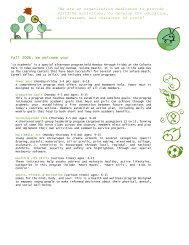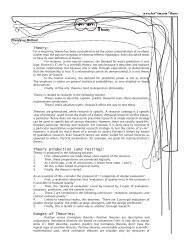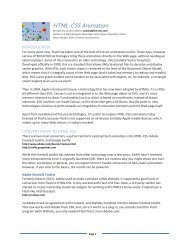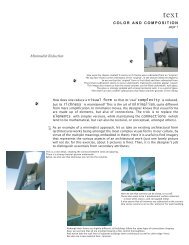ULTRAPERFORMING Beams/ Columns Doors ... - fen-om data
ULTRAPERFORMING Beams/ Columns Doors ... - fen-om data
ULTRAPERFORMING Beams/ Columns Doors ... - fen-om data
Create successful ePaper yourself
Turn your PDF publications into a flip-book with our unique Google optimized e-Paper software.
Carbon Fiber Surfacing<br />
Constructed entirely of carbon fiber, the Z5 chair weighs only 14 pounds but will withstand loads<br />
in excess of 1200 pounds. The technology used to construct this chair was originally developed<br />
for military applications and is a primary c<strong>om</strong>ponent in all advanced fighter aircraft. By exploiting<br />
the characteristics of this exotic material, Giovanni Pagnotta has created what appears to be an<br />
updated version of Gerrit Rietveld’s 1934 Zig-Zag stool which is “not only visually disarming but<br />
also extraordinarily c<strong>om</strong>fortable.” Z5 is available as shown in naked carbon, red, yellow, blue, or<br />
dressed in black leather.<br />
Concrete Canvas Shelter<br />
The Concrete Canvas Shelter is a rapidly deployable hardened shelter that requires only water<br />
and air for erection. It can be deployed by two people without any training in approximately thirty<br />
minutes and is ready to use in twelve hours. The shelter consists of a cement-impregnated fabric<br />
(Concrete Cloth) bonded to the outer surface of an inflatable plastic inner structure. Prior to<br />
construction, the shelter is delivered folded in a sealed plastic sack. Once the sack is positioned<br />
and filled with water, the fiber matrix wicks water into the cement, naturally controlling the<br />
water-to-cement ratio. The sack is cut open after hydration, and a battery-driven fan inflates the<br />
inner plastic lining, causing the structure to lift. After a duration of twelve hours, the concrete<br />
will have set sufficiently for use. The fibers of the Concrete Canvas fabric form a coherent matrix<br />
within the concrete, providing tensile reinforcement and helping prevent crack propagation. If<br />
desired, the shelter can be buried with over 0.5 meters of sand on the roof in order to provide<br />
increased insulation and protection.<br />
www.concretecanvas.co.uk<br />
Creative-Weave Metal Mesh<br />
Metal meshes have been known as decorative and functional design elements in architecture for<br />
only a few years. The French National Library in Paris was the first architectural project where<br />
GKD, in cooperation with French architect D<strong>om</strong>inique Perrault, succeeded in systematically<br />
implementing metal meshes in a building in various ways and applications. Since then, this<br />
development has continued worldwide. For decades, GKD has manufactured metal meshes for<br />
industrial applications in filtration and separation technologies and the process belt sector. At<br />
first, it was their visual attractiveness that made metal meshes suitable for the architecture and<br />
design sector. During the continuous product development it became clear that metal meshes also<br />
have considerable technical advantages which are extremely relevant in the field of architecture.<br />
Today, the architect has a wide range of mesh samples at hand, with weaving widths up to<br />
eight meters, which allow for great design flexibility. Woven metallic meshes used as partition<br />
elements convey a new dimension to any space. They can be used as projection screens, and,<br />
taking into account their acoustic characteristics,\ are suitable for the use in public buildings,<br />
opera houses and concert halls.<br />
www.gkd.de/englisch<br />
Floating Concrete<br />
By replacing sand and gravel with tiny polymeric spheres, University of Washington materials<br />
scientists have created a concrete stronger than traditional concrete but so light it floats in water.<br />
The team won a regional American Society of Civil Engineers Concrete Canoe C<strong>om</strong>petition.<br />
http://students.washington.edu/asce/canoe.shtml<br />
Foamed Aluminum<br />
“Light-as-air, stronger-than-steel materials are just beginning to shape our world. Foamed<br />
aluminum first emerged fr<strong>om</strong> the lab in the frame of a 1998 Karmann concept car. Ten times<br />
stronger than traditional aluminum at just one tenth the weight, the material allows a more fuelefficient<br />
vehicle. Its isotropic cellular structure helps the frame absorb shock and serves as an<br />
insulating firewall between the engine\ and the rest of the car. The foaming process can also be<br />
applied to steel, lead, tin, and zinc.” [Jessie Scanlon, Wired] CYMAT’s Aluminum Foam Division is<br />
an innovator in the use of closed cell aluminum foam for a wide variety of applications. Initially<br />
developed by Alcan International, this material won the National Research Council (Canada)<br />
Award for Product of The Year in 1993. The product is a high strength, extremely light weight<br />
material that possesses high durabilty, excellent finish and lasting value. The foam c<strong>om</strong>es in an<br />
assortment of densities and sizes up to five feet wide and up to fifty feet long. It has numerous<br />
applications including architectural, aut<strong>om</strong>otive, marine, military, aviation, transportation,<br />
electronics, appliances, signage and many more.<br />
www.cymat.c<strong>om</strong>/Cymat_Foam_products0.htm








